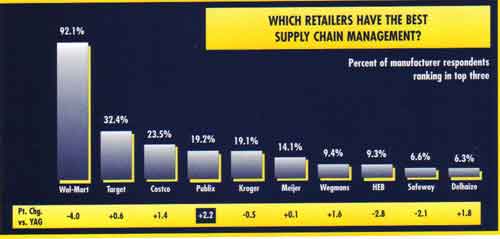Coca-Cola rose 2.6 points, which is actually a gain of 50% over its 2006 ranking.
The report notes that “Coca-Cola has initiated collaborative efforts with retailers to determine solutions for alternative schemes on supply chain. That includes potentially taking product through the warehouse instead of the traditional DSD system – something that Coca-Cola would never have contemplated even five years ago.” (See Coca Cola Appears to Have Settled Lawsuit Over Distribution to Retail Distribution Centers).
It also says that Unilever (up 1.8% over 2006) is “working on distribution methods that are considered leading edge- particularly in the Northeast – where distribution can often be complicated because of the relatively high cost.”
Retailer Supply Chain Rankings
No surprise, but Wal-Mart continued to dominate the retail supply chain rankings, with an amazing 92.1% of manufacturers putting it in their top 3. (See illustration nearby). Still, that’s down 4% points from last year, probably reflective of Wal-Mart’s controversial RFID program, and perhaps also its overall business challenges as sales growth slows and stock price languishes.
Target remained number 2, up a slight .6%. Number 4 Publix had the biggest percentage gain in the retail top 10, up 2.2%. The report notes that the grocer “is working closely with select manufacturers to shorten the distribution pipeline to its stores.”

Source: Cannondale Associates 2007 PoweRanking Study
Southwest grocer HEB, number 8 on the 2007 list and a company cited by many for its supply chain prowess, had the biggest drop in the retail top 10, at 2.8%, for reasons that are not clear. Small percentage changes like that are often just statistical variations.
The report notes that many retailers are just now starting to embrace programs like UCC-128 labeling and advance ship notices (ASNs). It quotes one manufacturer as saying “Kroger, Target and Wal-Mart are all working with us on ASN check-in. We’re not forcing this on anybody, but we are starting to realize some great efficiency through electronic interchange of data.”
Another noted that Food Lion, which did not make the top 10, was also embarking on a supply chain transformation.
“Food Lion is making the supply chain a large initiative, and requiring that we take notice,” said one CPG company. “We have improved the quality of our loads and the time it takes to deliver.”
Perhaps surprisingly, none of the drug store chains, which are for most CPG companies the fastest growing channel, made the top retail supply chain list, though CVS and Wal-Green’s showed up in other non-supply chain categories.
One thing we like about the Cannondale results is that there is really clear distinction among perceptions in different categories. For example, while Kroger rated number 5 in terms of supply chain, with a score about one-fifth of Wal-Mart’s rating, it scored a strong number two to Wal-Mart in the perception of the strength of its Category Management and Buying Teams, trailing by just a few percentage points.
This indicated respondents are not just listing the same retailers or manufacturers in the same basic order regardless of category. |